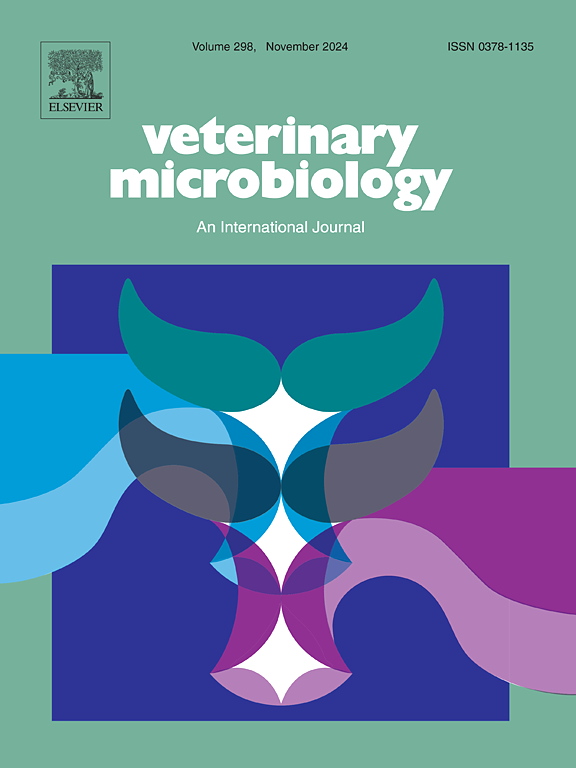伪狂犬病毒在感染后期抑制病毒复制的未折叠蛋白反应。
IF 2.4
2区 农林科学
Q3 MICROBIOLOGY
引用次数: 0
摘要
伪狂犬病毒(PRV)对全球养猪业和公共卫生构成重大威胁,但该病毒如何穿越宿主防御系统进行有效的病毒复制及其发病机制尚不清楚。在这里,我们报道了PRV可以抑制未折叠蛋白反应(UPR),在感染后期促进病毒复制,UPR是宿主对抗病毒感染的先天免疫的一个重要组成部分。在prv感染的细胞中,PERK被磷酸化并具有活性,但随后的事件,如eIF2α磷酸化、ATF4表达和应激颗粒(SGs)的形成,在病毒感染后被抑制。同时,IRE1α虽然也具有活性,但其激活的效应物XBP1s通过下调XBP1 mRNA水平和切割XBP1s蛋白而受到抑制。我们的研究结果还表明,在prv感染的细胞中,发生ATF6激活的高尔基体严重受损。同时,与三个UPR传感器相关的下游调控基因,如ERp60、CHOP和EDEM1,在prv感染的细胞中保持沉默。在UPR效应物ATF4或XBP1敲除后,观察到病毒复制增强,而用UPR激活物刺激可抑制病毒复制。总之,我们的研究结果解决了PRV如何调节细胞UPR以促进病毒复制的关键问题,并扩大了对病毒介导的UPR抑制的理解。本文章由计算机程序翻译,如有差异,请以英文原文为准。
Pseudorabies virus inhibits the unfolded protein response for viral replication during the late stages of infection
Pseudorabies virus (PRV) poses a significant threat to the global swine breeding industry and public health, but how the virus transverses the host defense systems for efficient viral replication and pathogenesis remains unclear. Here, we report that PRV could inhibit the unfolded protein response (UPR), a critical component of host innate immunity against viral infection, to promote virus replication during the late infection stages. PERK was shown phosphorylated and active in PRV-infected cells, but the subsequent events were suppressed post virus infection, such as eIF2α phosphorylation, ATF4 expression, and the formation of stress granules (SGs). In the meantime, although IRE1α was also active, its activated effector XBP1s was suppressed through downregulation of XBP1 mRNA levels and cleavage of XBP1s protein. Our findings also indicate that the Golgi apparatus, where ATF6 activation occur, was severely damaged in PRV-infected cells. Meanwhile, the downstream regulatory genes associated with the three UPR sensors, such as ERp60, CHOP, and EDEM1, remained silent in PRV-infected cells. Enhanced viral replication was observed post knockdown of UPR effectors ATF4 or XBP1, while stimulation with UPR activators inhibits virus replication. In conclusion, our findings address the critical question of how PRV regulates cellular UPR in favor of viral replication, and expand understanding of viruses mediated UPR suppression in general.
求助全文
通过发布文献求助,成功后即可免费获取论文全文。
去求助
来源期刊

Veterinary microbiology
农林科学-兽医学
CiteScore
5.90
自引率
6.10%
发文量
221
审稿时长
52 days
期刊介绍:
Veterinary Microbiology is concerned with microbial (bacterial, fungal, viral) diseases of domesticated vertebrate animals (livestock, companion animals, fur-bearing animals, game, poultry, fish) that supply food, other useful products or companionship. In addition, Microbial diseases of wild animals living in captivity, or as members of the feral fauna will also be considered if the infections are of interest because of their interrelation with humans (zoonoses) and/or domestic animals. Studies of antimicrobial resistance are also included, provided that the results represent a substantial advance in knowledge. Authors are strongly encouraged to read - prior to submission - the Editorials (''Scope or cope'' and ''Scope or cope II'') published previously in the journal. The Editors reserve the right to suggest submission to another journal for those papers which they feel would be more appropriate for consideration by that journal.
Original research papers of high quality and novelty on aspects of control, host response, molecular biology, pathogenesis, prevention, and treatment of microbial diseases of animals are published. Papers dealing primarily with immunology, epidemiology, molecular biology and antiviral or microbial agents will only be considered if they demonstrate a clear impact on a disease. Papers focusing solely on diagnostic techniques (such as another PCR protocol or ELISA) will not be published - focus should be on a microorganism and not on a particular technique. Papers only reporting microbial sequences, transcriptomics data, or proteomics data will not be considered unless the results represent a substantial advance in knowledge.
Drug trial papers will be considered if they have general application or significance. Papers on the identification of microorganisms will also be considered, but detailed taxonomic studies do not fall within the scope of the journal. Case reports will not be published, unless they have general application or contain novel aspects. Papers of geographically limited interest, which repeat what had been established elsewhere will not be considered. The readership of the journal is global.
 求助内容:
求助内容: 应助结果提醒方式:
应助结果提醒方式:


